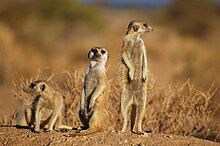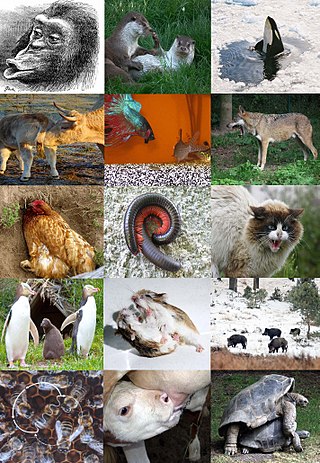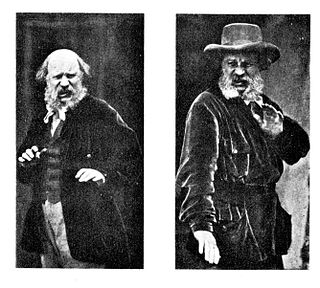Social learning mechanisms
Social learning occurs when one individual influences the learning of another through various processes. In local enhancement and opportunity providing, the attention of an individual is drawn to a specific location or situation. [1] In stimulus enhancement, emulation, observational conditioning, the observer learns the relationship between a stimulus and a result but does not directly copy the behavior of the experienced individual. In imitation, the observer directly copies the behavior of the animal in order to complete a novel task. In emulation, the observer learns a goal from the observed animal’s behavior and seeks to achieve the same results while not following all of the same steps. All of these mechanisms are possible through inadvertent social learning, without active facilitation from the experienced individual. [1] When an individual more actively influences another's behavior through any one of these mechanisms, the individual becomes a teacher. [1]
Local enhancement
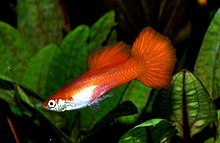
In local enhancement, a demonstrator attracts an observer's attention to a particular location. [1] One seminal study with guppies (Poecilia reticulata) demonstrated how local enhancement influenced foraging behavior. [13] Untrained adult female guppies (observers) were given five days of experience swimming with demonstrator fish trained to take one of two equivalent routes to food. When these observers were later isolated, they preferentially used the route their demonstrators had used. These results indicate that guppies learn about their local environments through the social learning mechanism of local enhancement. [12]
Local enhancement has also been observed to transmit foraging information in among birds, rats, and pigs. [3]
Opportunity providing
Opportunity providing is a social learning mechanism in which the experienced individual puts the observer in a situation that facilitates the acquisition of knowledge or a new skill. [1] A well known example of unintentional opportunity providing is the transmission of feeding behavior in black rats (Rattus rattus). One pilot study determined that black rats living in the forests of Palestine preferentially fed on pine cones instead of other fresh fruits and vegetation nearby. These rats also methodically stripped pine cones rather than gnawing at them randomly. [14] To determine how these food preferences developed, researchers provided naive adult black rats with fresh pine cones in captivity and observed their behavior. After three months of experimentation, they found that none of the rats had successfully opened the pine cones and had instead haphazardly and inefficiently attempted to feed on the cones. [15] In further experiments, the rats were allowed to observe experienced individuals opening the pine cones but were still unable to pick up the skill of pinecone stripping. Eventually, the researchers determined that naive adult rats could learn to strip pine cones efficiently if presented with an already partially stripped cone. This is consistent with opportunity providing because experienced individuals inadvertently provide naive rats with partially stripped cones that facilitate their learning without altering the experienced rats' behavior. [1]
Opportunity providing has also been found to be important in the acquisition of tool use by chimpanzees, in which a mother chimpanzee may contribute to the development of her offspring's nut cracking technique by leaving "hammer", either hard wood or rocks, and nuts in the nest. The infant is thus given the chance to use the hammer in the “proper” context. The mother chimpanzee may provide this opportunity unknowing or actively depending on the situation. [16]
Stimulus enhancement and observational conditioning
In stimulus enhancement, a demonstrator exposes an observer to a particular stimulus, leading to the observer learning the relationship between a stimulus and its result. [1] A study investigating stimulus enhancement in greylag geese (Anser anser) found that individuals that had previously observed a human opening a box preferentially spent more time investigating the box and attempting to open it via trial and error. These geese were also more successful at eventually opening the box in comparison to control geese that had not previously observed a human opening the box. [17]

Observational conditioning is a phenomenon similar to stimulus enhancement. In observational conditioning, the behavior of the demonstrator exposes the learner to a new relationship between stimuli that it had not previously known, and causes the learner to form an association between them. [1] In an experiment with rhesus macaques (Macaca mulatta), young monkeys that observed their parents fearfully responding to model snakes also developed a fear of snakes without direct contact. After three months, the observer rhesus macaques still showed strong fearful reactions toward snakes, suggesting that they had formed a strong connection from just observing their parents’ behavior. [18] Another example of this is how blackbirds learn to identify predators; they observe other birds mobbing unfamiliar objects they haven't seen before. [19]
Imitation and emulation
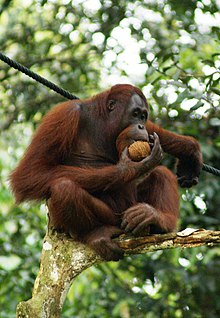
Though the exact definition of imitation is a topic of debate within scientific literature, broadly, in imitation a learner observes a unique action performed by the demonstrator and learns to reproduce the behavior with detectable behavior matching. (This differs from "copying" in which the learner reproduces that same action but this is performed with a different part of the body e.g. the left paw is used instead of the right paw.)
Emulation is similar to imitation in that after observing a demonstrator interacting with objects in its environment, an observer is more likely to act to bring about a similar effect on those objects, but not necessarily through the same method. [1] For example, emulation may include using a tool to achieve a goal such as reaching otherwise inaccessible food after observing another to do such a task but using the tool in a different way than the model. The term 'emulation' encompasses a scope of distinct social learning processes, including object movement re-enactment, end-state emulation, and affordance learning. [20] Object movement re-enactment is the extraction and copying of certain steps of a process of a model moving an object. End-state emulation is the copying of the results of a model's actions using the observer's own unique means. Affordance learning deals with the idea that an observer can gain information about physical properties of the environment and objects within it and how those may interact and then use such information to complete a task.
One key distinction between imitation and emulation is copying fidelity. High-fidelity is associated with imitation. In studies comparing behaviors of chimpanzees and human children, the human children were typically shown to perform high-fidelity imitation, what may even be considered 'over-imitation.' Meanwhile chimpanzee responses depended more on context such as causal relevance of actions. [21] [22] Fidelity of behavior copying and transfer reportedly plays a role in cultural transmission, so understanding copying fidelity in non-human animals may be important for understanding their capacity for cultural transmission and cumulative culture.
Much of the research that has been conducted on imitation and emulation in animals has centered around primates due to their advanced cognitive capacities and evolutionary proximity to humans. Examples of studies that have explored these capacities and tendencies in primates are listed in a table within the ‘Research on Imitation and Emulation in Primates’ section below.
Beyond the studies listed, in a naturalistic environment, imitative learning is seen in many animal species. Many species of songbirds learn their songs through imitation, and it has been hypothesized that chimpanzees' understanding of intentionality of action in other members of a social group influences their imitative behaviors. [23]
Imitation of birdsong
As a sexually selected trait, variation in learning of songbird calls is often studied. Lahti et al. performed a study on swamp sparrows (Melospiza georgiana) where young sparrows were exposed to song models with controlled trill rates. [24] Higher trill rates are more difficult to perform and thus are likely more desired in birdsong performance. When exposed to low-performance models, it was found that the learner sparrows sacrificed imitative accuracy for higher performance, while when exposed to high-performance models, imitation was very accurate. The researchers suggest that this study may provide insight into how behaviors learned through imitation can still be selected for due to level of performance.
Sewall explored the variation in learned bird songs in relation to social and genetic intermixing of families of red crossbills (Loxia curvirostra). [25] When given to foster parents, it was shown that fledgling crossbills will imitate the particular variations in their foster parents' calls. It was thus hypothesized that such idiosyncrasies in call could aid in creating familial cohesion and that when such call variants are passed down generations, those variants are direct signals of the crossbill's genetic and familial history.
MacDougall-Shackleton summarized research that suggests developmental stressors affect bird song learning, and that such discrepancies in call can be identified and selected against in some species of birds. [26] He suggests that while many studies have shown that several species of songbirds prefer the song dialect of their local area, current data is lacking in explaining why this is so. It has been argued that genetic factors may play into this preference as well as social learning. [27] In this study, three separate groups of laboratory-raised house finches (Carpodacus mexicanus) were raised hearing the local song dialect, a foreign song dialect, or no song. When adults, all finches showed sexual preference for the local dialect, suggesting an inherited component to song preference.
Visual behavioral imitation
Pigeons are able to learn behaviors that lead to the delivery of a reward by watching a demonstrator pigeon. [28] A demonstrator pigeon was trained to peck a panel in response to one stimulus (e.g. a red light) and hop on the panel in response to a second stimulus (e.g. a green light). After proficiency in this task was established in the demonstrator pigeon, other learner pigeons were placed in a video-monitored observation chamber. After every second observed trial, these learner pigeons were then individually placed in the demonstrator pigeon's box and presented the same test. The learner pigeons displayed competent performance on the task, and thus it was concluded that the learner pigeons had formed a response-outcome association while observing. However, the researchers noted that an alternative interpretation of these results could be that the learner pigeons had instead acquired outcome-response associations that guided their behavior and that further testing was needed to establish if this was a valid alternative.
The performance of opening an artificial fruit after watching a demonstrator was tested in groups of adult pig-tailed macaques (Macaca nemestrina) and compared to adult humans. [29] The macaques showed weak evidence of imitative learning compared to the adult humans. It was hypothesized that because the macaques were adults, they were less likely to imitate than juvenile monkeys, as accurate imitation may be an adaptation that is more useful to juveniles.
Mechanisms for imitative learning
Mechanisms that support imitative learning have been studied on the neurological level. Roberts et al. performed research on zebra finches (Taeniopygia guttata) that explored the importance of neural motor circuitry on birdsong learning. [30] If the premotor nucleus was disrupted while a juvenile finch was learning a song from an older finch, the song was not copied. Images of a finch undergoing various neural manipulations showed that premotor circuits aid in encoding information about songs.
Mirror neurons have been implicated as the link in primate brains between visual observation and motor representation. [31] These special neurons, originally discovered in area F5 of the ventral premotor cortex of monkeys, are activated when an individual performs a certain action and when that individual observes another (human or monkey) performing a similar action. Ferrari, Bonini, and Fogassi [32] worked to explain how the mirror neuron framework could account for imitation of a multiple phenomena with ranging complexities and cognitive demands; they proposed a ‘direct mirror pathway’ for earlier, more automatic imitation and an ‘indirect mirror pathway’ that seems important for more complex and efficient imitative behaviors.
Behavioral mechanisms have also been studied. Cecilia Heyes at the University of Oxford argues that the mechanisms underlying social learning in both humans and nonhumans are analogous to those of non-social learning. [33] Observational learning, then, only becomes social when perceptual, attentional, and motivational factors are focused on other organisms by genetic or developmental forces.
Research on Imitation and Emulation in Primates
In considering imitation and emulation in non-human animals, much of the research has centered around the presence or absence of these abilities in primates. The table below provides an overview of the field of research related to possible imitation and emulation in primates.
| Likely learning mechanism | Positive or negative support | Genus | Behavior(s) | Citation |
|---|---|---|---|---|
| Imitation | Positive | Pongo (Orangutan) | Kiss imitation | Abel (1818) [34] |
| Digging with spade | Furness (1916) [35] | |||
| Lifting lid of sewage tank | Yerkes and Yerkes (1927) | |||
| Building nests, feeding habits | Harrison (1960) [36] | |||
| Flaking stone tools | Wright (1972) [37] | |||
| Tool use | Galdikas (1982) [38] | |||
| Macaca (Macaque) | Opening oysters with stones | Carpenter (1887) [39] | ||
| Plug pulling, lever pressing, box opening | Kinnaman (1902) [40] | |||
| Botanical collection (assisting experimenter) | Carner (1955) [41] | |||
| Potato washing, rice throwing, consumption of caramel | Imanishi (1957) [42] | |||
| Jumping over barrier to avoid electric shock | Presley and Riopelle (1959) [43] | |||
| Fear response | Miller et al. (1959) [44] | |||
| Throwing tool at unreachable food | Beck (1976) [45] | |||
| Reaching food with metal rods | Anderson (1985) [46] | |||
| Fear of snakes | Cook et al. (1985) [47] | |||
| Pan (Specifically Chimpanzees) | Door opening, using keys in locks, regulating water supply with lever, scrubbing floor, sweeping with broom | Rothman and Teuber (1915) [48] | ||
| Opening watch | Shepherd (1915) [49] | |||
| Digging with spade, screwing screw, scrubbing, sweeping | Furness (1916) [35] | |||
| Wiping nose with handkerchief, hammering nails, sewing | Sheak (1923) [50] | |||
| Using paintbrush, stacking boxes to reach banana | Kohler (1925) [51] | |||
| Washing clothes | Kearton (1925) [52] | |||
| Brushing hair, opening cupboards | Kellogg and Kellogg (1933) [53] | |||
| Spitting, imitating facial expressions | Yerkes (1943) [54] | |||
| Brushing hair, applying lipstick, brushing teeth, sharpening pencils | Hayes (1951) [55] | |||
| Imitation on command | Hayes and Hayes (1951) [56] | |||
| Solving stick and tunnel problems, solving stick and string problems, throwing ball | Hayes and Hayes (1952) [57] | |||
| Patting head, clapping hands, sticking out tongue | Hayes and Hayes (1953) [58] | |||
| Termite Fishing | van Lawick-Goodall (1973) [59] | |||
| Cracking nuts with stones, techniques for reaching lower tree branches | Sugiyama and Koman (1979) [60] | |||
| Limping gait | De Waal (1982) [61] | |||
| Ant species selection | Nishida and Hiraiwa (1982) [62] | |||
| Cracking walnuts with stones | Sumita et al. (1985) [63] | |||
| Sign language | Fouts et al (1989) [64] | |||
| Play initiation by throwing chips | Tomasello et al. (1989) [65] | |||
| Trigger light or sound by using head, foot, or sitting (greater imitation when observed was hands free and making unconstrained action) | Buttelmann et al. (2007) [66] | |||
| Action imitation | Carrasco et al. (2009) [67] | |||
| Gorilla | Matching moods and play behaviors | Carpenter (1937) [68] | ||
| Papio (Baboon) | Digging in certain locations | Hall (1963) [69] | ||
| Fruit cracking with stones | Marais (1969) [70] | |||
| Fishing | Hamilton and Tilson (1985) [71] | |||
| Ateles (Spider Monkey) | Putting things in mouth, bell ringing, object examination, bucket interactions | Chevalier-Skolnikoff (1989) [72] | ||
| Cebus (Capuchin) | Banging objects together, putting tub in moat, putting cloth on branch | Chevalier-Skolnikoff (1989) [72] | ||
| Negative | Cebus | Box opening | Thorndike (1901) [73] | |
| Cracking nuts | Antinucci and Visalberghi (1986) [74] | |||
| Cracking nuts | Visalberghi (1987) [75] | |||
| Probing for syrup | Westergaard and Fragaszy (1987) [76] | |||
| Puzzle solving | Adams-Curtis (1987) [77] | |||
| Moving reward in tube | Visalberghi and Trinca (1987) [78] | |||
| Nut cracking, moving reward in tube with stick | Fragaszy and Visalberghi (1989) [79] | |||
| Papio | Reaching food with tool | Beck (1972) [80] | ||
| Macaca | Reaching pan using stick | Beck (1974) [81] | ||
| Emulation | Positive | Pan (Specifically Chimpanzees) | Reaching food with tool | Tomasello et al. (1987) [82] |
| Reaching food with tool | Nagell et al. (1993) [83] | |||
| Tube opening | Call et al. (2005) [21] | |||
| Accessing food reward from puzzle box (in clear condition when causal vs irrelevant steps could be observed) | Horner and Whiten (2005) [22] | |||
| Pongo | Reaching food with tool | Call and Tomasello (1994) [84] |
